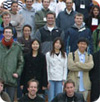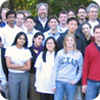Test2
From 2006.igem.org
(Difference between revisions)
| Line 1: | Line 1: | ||
== Previous Years == | == Previous Years == | ||
| - | {|border=" | + | {|border="0" cellpadding="6" cellspacing="0" align="left" |
| - | + | ||
!width=100px style="valign:top"| | !width=100px style="valign:top"| | ||
| - | !width= | + | !width=30px style="valign:center"| |
| - | + | !width=600px style="valign:top"| | |
| - | !width= | + | |
| - | + | ||
| - | + | ||
|- | |- | ||
|[[Image:2005-logo.jpg]] | |[[Image:2005-logo.jpg]] | ||
| - | | | + | |'''2005''' |
| - | + | |In the summer of 2005, 13 teams worked on projects involving chemotaxis regulation systems, cell-cell genetic communications systems, cellular/biological wires, thermometers, biological sketch pads (drawing systems), cellular relay races, a digital counter, and more. [[Igem 2005|Read more]] | |
| - | + | |- | |
| - | + | ||
|[[Image:2004-logo.jpg]] | |[[Image:2004-logo.jpg]] | ||
| - | + | |'''2004''' | |
| - | + | |This year marked the first true Synthetic Biology Competition. Teams from five schools competed to build cellular state machines and counters. The teams came together for a ''jamboree'' in early November to compare their results. The most graphic project was "photographic biofilm" that could capture an image (now called ''coliroid film''). [[Igem 2004|Read more]] | |
| - | + | ||
| - | |''' | + | |
| - | + | ||
| - | + | ||
| - | | | + | |
| - | + | ||
| - | + | ||
| - | + | ||
| - | + | ||
|} | |} | ||
Revision as of 15:05, 14 August 2006
Previous Years

| 2005 | In the summer of 2005, 13 teams worked on projects involving chemotaxis regulation systems, cell-cell genetic communications systems, cellular/biological wires, thermometers, biological sketch pads (drawing systems), cellular relay races, a digital counter, and more. Read more |

| 2004 | This year marked the first true Synthetic Biology Competition. Teams from five schools competed to build cellular state machines and counters. The teams came together for a jamboree in early November to compare their results. The most graphic project was "photographic biofilm" that could capture an image (now called coliroid film). Read more |